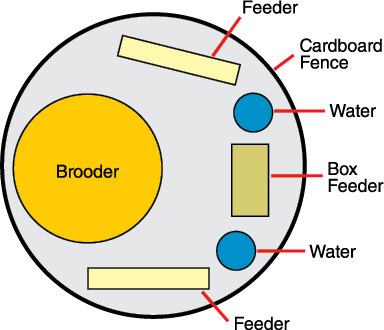A special brooder house or a building can be used for rearing chickens. If chicks are purchased in winter or early spring, make sure the building has enough insulation and minimal drafts to maintain the chicks heat requirements. If such facilities are not available, use an area of another building, such as a garage or basement which can be penned off.
An area within the brooder house or room should be sectioned off with a chick guard and a light placed in the center of the area. Use roll roofing metal or something similar to make a circle around the light. Do not make square corners because the chicks will pile up in these corners. Stock water tanks also work well for brooding chicks.
Suggested chicken housing
For the first month, confine chicks to the brooder area by using a 24-inch-high chick guard. The guard keeps the little birds from straying away from the heat and prevents floor drafts. Keeping the brooding area large enough to allow chicks to escape one another and allow them to choose their comfort zone around the light is important; however, the brood area should not be so large that a proper temperature cannot be maintained. Chicks in general will require ½ square foot of housing or brooder space per bird up to six weeks of age. Depending on the breed, growing pullets require 1 ½ to 2 ½ square feet of confined floor space per bird.
For used housing, be sure to clean and sanitize thoroughly, including all surrounding walls, troughs, perches, and nests before receiving chicks. Scrub the walls and floor with a good disinfectant. Ensure all cracks are cleaned and all old litter removed. Mix one tablespoon of bleach to one-gallon of boiling water to make a disinfectant solution. Also, be sure to clean and disinfect all feed and watering equipment.
Once the housing is dry, put down a quality bedding litter. Pine wood shavings are good litter and absorb well. Expanded vermiculite or mold-free straw can also make good litter. Remove wet spots and apply fresh litter as needed. Chick starter paper or newspaper may be placed over the litter during the first five days to prevent the chicks from eating the litter. Ensure the paper is not slick.
Proper spacing is important as cannibalism may occur from overcrowding, too little space, poor nutrition, poor ventilation, too much light or injured birds. Keep new chicks isolated from older birds until they are fully feathered out to prevent injury and disease spreading to younger chicks. Make sure chicks are confined to areas that will not allow access for predators such as dogs, cats, coyotes, racoons, skunks, and weasels.

